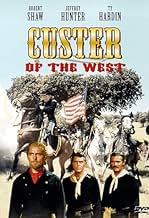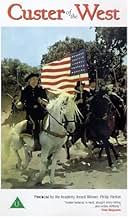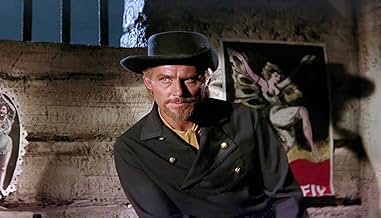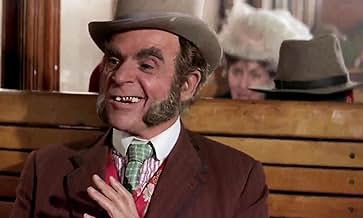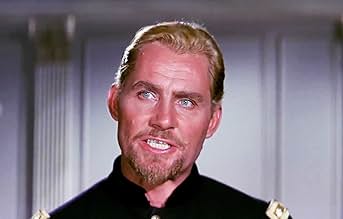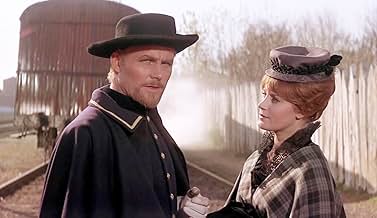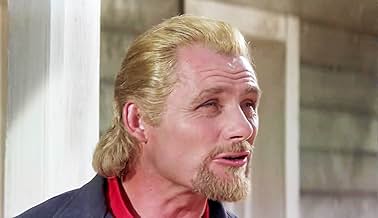IMDb RATING
5.8/10
1.7K
YOUR RATING
George Armstrong Custer's love of the heroic traditions of the Calvary and his distaste with the coming of industrialization leads him to his destiny at the Little Big Horn.George Armstrong Custer's love of the heroic traditions of the Calvary and his distaste with the coming of industrialization leads him to his destiny at the Little Big Horn.George Armstrong Custer's love of the heroic traditions of the Calvary and his distaste with the coming of industrialization leads him to his destiny at the Little Big Horn.
- Director
- Writers
- All cast & crew
- Production, box office & more at IMDbPro
Featured reviews
I'll make this short and sweet, on second thought, I'll try to! For anyone who has studied history and even scanned a chapter about Custer, could tell that this story line seemed to be made-up as it went along. I have watched this movie only once, and that was more than enough. I understand Hollywoods need to add to, or change charactors or situations to sell a movie. BUT, when they feel the need to give Gen. Armstrong Custer an english accent, Wow!!! Flags went up as soon as he spoke. Ok, ok, overlook that. The thing that gets me the most is the way this movie seems to change the man, to what (I Guess) they wish he was. That too can be overlooked. But, when you change history around to such extremes as, lets pick on the Battle of the Little Big Horn. The way it is acted out is not only corny, but totally oblivious to the truth. The movie has Custer confronting the Indians right before the battle, (According to both versions{The Indians & The Whites} of history, HE DIDN'T).In the movie he didn't flee up the hill(as he did inreal life), away from the village, then finally dismount at almost the top of a hill, surrounded, there to die, and where some mutilations took place.Custer, being the last man standing(YEA, RIGHT!), gets an offer from the chief to let him go, (There was no, I repeat NO SUCH OFFER!) as there was in the movie. Enough you say, there had to be some good. Robert Ryan, in his, much to small a part, was, as usual top notch. However, the story being sooo far fetched ruined it for me. MY RATING: For the valid attept to make a movie,I give 1 Star, Add 1 Star for some decent Charactor Actors, & add 2 for Robert Ryans far too few moments. But, I have to subtract 1 just becaus they thought we wouldn't notice the english accent. 3 Out of 10 STARS
Okay gang, this is a deeply flawed Custer movie. There is no getting away from that. Yet, if you have any interest at all in the Custer legend (notice I said legend - any relationship to real history and this movie is purely coincidental), and want to see a riveting performance by Robert Shaw, complete with an absurd English accent for Custer, this is a must see movie.
Besides the imaginary history, the geographical locations presented for the story exist only in the minds of the screen writer and director. Despite this, I could not get over how much I liked watching Shaw present his interpretation of Custer. For all the weaknesses in the script, Shaw was given some great speeches to make, demonstrating the tragedy of plains Indians. No matter how ugly the near genocide of them as a people and the total genocide of their culture, and there is no excuse for any of it, they were the victims of events that were pre-determined once Europeans set foot on North America. A point perfectly captured in the movie in the confrontation between Custer and an American actor posing as a representative Indian chief.
For myself, the worst part of the movie, which I was enjoying up to this point, was the Last Stand. Who cares whether it was accurate or not. When was the last time Hollywood ever made any movie about any historical event or person that was not clearly fiction in many aspects? What bothered me, was the fact it was done on the cheap. Custer had around 260 men with him, in the movie, he might have about 50. There is just no drama in watching a big action sequence that falls flat because you were not willing to hire more extras.
Still, I guess this movie is one of my guilty pleasures. If you like action movies or Robert Shaw, give it a look.
Besides the imaginary history, the geographical locations presented for the story exist only in the minds of the screen writer and director. Despite this, I could not get over how much I liked watching Shaw present his interpretation of Custer. For all the weaknesses in the script, Shaw was given some great speeches to make, demonstrating the tragedy of plains Indians. No matter how ugly the near genocide of them as a people and the total genocide of their culture, and there is no excuse for any of it, they were the victims of events that were pre-determined once Europeans set foot on North America. A point perfectly captured in the movie in the confrontation between Custer and an American actor posing as a representative Indian chief.
For myself, the worst part of the movie, which I was enjoying up to this point, was the Last Stand. Who cares whether it was accurate or not. When was the last time Hollywood ever made any movie about any historical event or person that was not clearly fiction in many aspects? What bothered me, was the fact it was done on the cheap. Custer had around 260 men with him, in the movie, he might have about 50. There is just no drama in watching a big action sequence that falls flat because you were not willing to hire more extras.
Still, I guess this movie is one of my guilty pleasures. If you like action movies or Robert Shaw, give it a look.
I won't go on too long about this. It's an efficiently told, largely fictional story of Custer and his last stand, sweetened up for the Whites in the audience and for their children.
It's impossible to imagine an American Indian watching this without feeling nauseous. Kieron Moore as Dull Knife. And at the end Custer seems to be fighting the Cheyenne -- period -- whereas he fought Sioux almost entirely. There were only seven Cheyenne warriors present at the battle. Westerns seem to enjoy dealing with the Cheyenne whenever they need generic Indians. I think it may be the name of the tribe -- The Cheyenne. It's easy to pronounce, and it sounds good. (It means something like "people with red feet" in Cheyenne.) "Sioux," on the other hand, sounds like a girl's name. "Apache" and "Comanche" are euphonious generic names too, but it's hard to get them all the way up to Montana. So what are you left with -- "Paiute"?
I didn't mind Robert Shaw's accent. He's a decent playwright but, regardless of which accent he's using, he can project nothing more than grim determination. When he seems to be enjoying himself, maybe smiling, you can't help feeling that it's calculated, that he's grimly determined to smile. As written, his role doesn't tell us much about Custer. Sometimes he seems brutal and other times, without too much tiresome exposition, he sounds like a liberal. Mary Ure is really appealing, a decent actress, without being staggeringly beautiful, who died an untimely death. Ty Hardin wasn't much of an actor, and he seemed to go politically bonkers after his brief career as a handsome hunky type. Jeffrey Hunter has a small part as the voice of humanitarianism. Lawrence Tierney has a beaut of a New York accent, but it may not be too out of place. Phil Sheridan was from New Jersey, wasn't he? (I may be wrong, but I don't want to bother looking it up.) Robert Ryan is the best actor in the bunch and his part is completely unnecessary, adding nothing to the picture.
The last stand is epic in a way it probably wasn't in real life, if that matters at all. The dead cavalrymen all wind up in something like a circular pile instead of being scattered along the slope up which they retreated. The Indians leave the remains alone, too, instead of violating them as they actually did. (Custer's body was stripped but unmutilated.) Indians tend not to like this kind of movie. On the anniversary of the battle in 1988 they installed a small plaque of crude, angry cast iron commemorating the many Indians who died in the battle. Right in the shadow of the phallic needle that remembers the 7th Cavalry. As it happens, I was living with the Cheyenne as an anthropologist at the time. I have never met a more admirable people. You don't hear much about Indian resentment of White's assumed superiority because they don't shout loud enough. Jane Fonda on her return from France in 1970 found them boring and too fond of alcohol so she went on to more exciting things.
It's impossible to imagine an American Indian watching this without feeling nauseous. Kieron Moore as Dull Knife. And at the end Custer seems to be fighting the Cheyenne -- period -- whereas he fought Sioux almost entirely. There were only seven Cheyenne warriors present at the battle. Westerns seem to enjoy dealing with the Cheyenne whenever they need generic Indians. I think it may be the name of the tribe -- The Cheyenne. It's easy to pronounce, and it sounds good. (It means something like "people with red feet" in Cheyenne.) "Sioux," on the other hand, sounds like a girl's name. "Apache" and "Comanche" are euphonious generic names too, but it's hard to get them all the way up to Montana. So what are you left with -- "Paiute"?
I didn't mind Robert Shaw's accent. He's a decent playwright but, regardless of which accent he's using, he can project nothing more than grim determination. When he seems to be enjoying himself, maybe smiling, you can't help feeling that it's calculated, that he's grimly determined to smile. As written, his role doesn't tell us much about Custer. Sometimes he seems brutal and other times, without too much tiresome exposition, he sounds like a liberal. Mary Ure is really appealing, a decent actress, without being staggeringly beautiful, who died an untimely death. Ty Hardin wasn't much of an actor, and he seemed to go politically bonkers after his brief career as a handsome hunky type. Jeffrey Hunter has a small part as the voice of humanitarianism. Lawrence Tierney has a beaut of a New York accent, but it may not be too out of place. Phil Sheridan was from New Jersey, wasn't he? (I may be wrong, but I don't want to bother looking it up.) Robert Ryan is the best actor in the bunch and his part is completely unnecessary, adding nothing to the picture.
The last stand is epic in a way it probably wasn't in real life, if that matters at all. The dead cavalrymen all wind up in something like a circular pile instead of being scattered along the slope up which they retreated. The Indians leave the remains alone, too, instead of violating them as they actually did. (Custer's body was stripped but unmutilated.) Indians tend not to like this kind of movie. On the anniversary of the battle in 1988 they installed a small plaque of crude, angry cast iron commemorating the many Indians who died in the battle. Right in the shadow of the phallic needle that remembers the 7th Cavalry. As it happens, I was living with the Cheyenne as an anthropologist at the time. I have never met a more admirable people. You don't hear much about Indian resentment of White's assumed superiority because they don't shout loud enough. Jane Fonda on her return from France in 1970 found them boring and too fond of alcohol so she went on to more exciting things.
Robert Shaw plays the inimitable General George Custer, portraying him here as a statesman, a man of integrity, humility and at times, sympathy. His respect for Chief Dull Knife (Moore) is evident in the manner in which he addresses his foe, but the depth of his jingoist patriotism is equally apparent as he almost laments "you are a militarily defeated people". He does this again, rebuking Robert Ryan's desperate bid for clemency after he's sentenced to death for desertion. "I've got to have new facts" he pleads. Of course Ryan has no rebuttal. Shaw delivers a complex characterisation, one that opens further each time you watch.
The accent employed by Shaw is sometimes distracting, but it's not the liability some complain. Supporting performances are played with conviction, particularly Ty Hardin as the boozing Major, who finds Custer's work ethic an unwelcome interruption to his inertia, and Jeffrey Hunter as an Injun-sympathiser, the teacher drafted into the cavalry, looking for some semblance of moral justice amid the chaos. Needless to say, he resigns to futility, as does Custer in his final stand at Little Big Horn.
Perhaps the most revealing character trait chosen by Shaw in this interpretation, is his tendency to seek advice from his wife (Ure). Often absorbed by immense self doubt and political pressure, Ure is his constant sounding board. While this edge gives Shaw's Custer an interesting new dimension to an otherwise wholly glorified character in the movies to this point, it does largely waste Ure's talents as she rocks, knits and conjures pearls of wisdom for her conflicted husband to ponder. More liberty (e.g. removing the superfluous congress speech, the log-ride scene or the bizarre musical) with the guillotine could have cut 20-30 minutes off this epic tale, which is often paralysed by lengthy passages of dialogue and irrelevant plot diversions. Overall, while it certainly improves with each viewing, it's perhaps irrevocably flawed and overlong.
The accent employed by Shaw is sometimes distracting, but it's not the liability some complain. Supporting performances are played with conviction, particularly Ty Hardin as the boozing Major, who finds Custer's work ethic an unwelcome interruption to his inertia, and Jeffrey Hunter as an Injun-sympathiser, the teacher drafted into the cavalry, looking for some semblance of moral justice amid the chaos. Needless to say, he resigns to futility, as does Custer in his final stand at Little Big Horn.
Perhaps the most revealing character trait chosen by Shaw in this interpretation, is his tendency to seek advice from his wife (Ure). Often absorbed by immense self doubt and political pressure, Ure is his constant sounding board. While this edge gives Shaw's Custer an interesting new dimension to an otherwise wholly glorified character in the movies to this point, it does largely waste Ure's talents as she rocks, knits and conjures pearls of wisdom for her conflicted husband to ponder. More liberty (e.g. removing the superfluous congress speech, the log-ride scene or the bizarre musical) with the guillotine could have cut 20-30 minutes off this epic tale, which is often paralysed by lengthy passages of dialogue and irrelevant plot diversions. Overall, while it certainly improves with each viewing, it's perhaps irrevocably flawed and overlong.
The film begins at the end of the Civil War and ends with the death of Custer and his troops at the Battle of Little Big Horn. It was filmed in single-camera Cinerama and had an impressively large cast.
I think your enjoyment of "Custer of the West" depends a lot on what your opinions are of the man, if any. As a former US History teacher, I look on the man as a very failed (if not a bit stupid) leader...so since I am not a fan, it made enjoying the film more difficult. More difficult still is that the movie didn't do a lot to humanize the man or tell you who he was apart from some general/lieutenant colonel.
Overall, reasonably good but not exactly a crowd-pleaser.
I think your enjoyment of "Custer of the West" depends a lot on what your opinions are of the man, if any. As a former US History teacher, I look on the man as a very failed (if not a bit stupid) leader...so since I am not a fan, it made enjoying the film more difficult. More difficult still is that the movie didn't do a lot to humanize the man or tell you who he was apart from some general/lieutenant colonel.
Overall, reasonably good but not exactly a crowd-pleaser.
Did you know
- TriviaSome sources have suggested that this was originally to be directed by Akira Kurosawa, but he pulled out. However, this is massively unlikely, given the production history of the film. The more likely explanation is that Kurosawa was approached about directing a different film project on the same subject, "The Day Custer Fell", which was in the works at 20th Century Fox for several years, and for which several Japanese actors famous for working with Kurosawa were approached to play the leading Native American roles. Fred Zinnemann was eventually attached to this project, but it was canceled by Fox because of its ever-escalating budget. "Custer Of The West" was put together very quickly (and made rather cheaply) once this occurred.
- GoofsThe troops of the 7th Cavalry are shown with 1873 Winchester rifles, which were in wide use by 1876, but not by the US Army. Custer's men were armed, as all troopers who did not purchase their own rifles were, with the 1873 Springfield Trapdoor carbine, a single-shot weapon. Had Custer's men been armed with the Winchester, it is possible, though unlikely, that they could have held out until relieved.
- Quotes
Gen. Philip Sheridan: You know, you could become a living legend... or get yourself killed. Dead men make better legends.
- Alternate versions35mm prints released in both complete and shortened versions. Some shortened versions were titled "A Good Day for Fighting".
- ConnectionsFeatured in I Am Not Your Negro (2016)
- How long is Custer of the West?Powered by Alexa
Details
Box office
- Budget
- $4,000,000 (estimated)
- Runtime
- 2h 20m(140 min)
Contribute to this page
Suggest an edit or add missing content

